Vintage Veloce
pro rider
In a separate thread I brought up the idea of swapping out the rear spring on my 2020 Svartpilen 401.
Today, I swapped out the rear spring.
I had purchased an H&R HRF 180 60 130 (180mm free length, 60mm ID, 130 N/mm). This spring rate was recommended by some experts for my weight, 165 pounds (75kg) with all my gear.
The spring was approximately US$ 70 including shipping.
It was harder to swap the springs than I had anticipated. The shock bolts were rather tight, with either a locking compound or maybe poor bolt machining. I found other bolts on the Bajaj manufactured bike to be a bit rough on the threads too... so I recommend having a tap and die set available to clean up the threads. You also need a spring compression tool and a way to unweight the rear suspension, so many might prefer to have a professional do this kind of thing.
Here is my bike on the my lift:
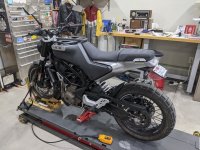
Here how I unweighted the rear wheel:
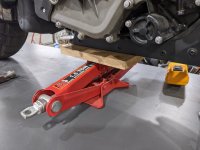
This is the original (white) and the new (red) spring:
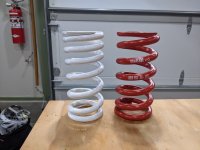
Putting the new spring on:
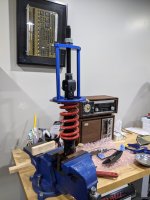
Pictures of the new spring installed:
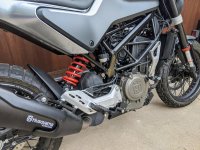
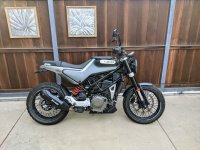
I actually like the red color. I had planned on painting the spring black, but red matches the plastic trim on the front fork and I like it!
I checked the free and rider sag, and it seems good. The stock spring is progressive, and this new one is a flat rate. This does help to provide less sag, as there is no soft beginning to the spring.
I did set the bike up with less rider sag (26mm) than I had with the original spring, as I thought I had too much there. Pushing down on the seat, it does feel good, I think that is just because it isn't progressive.
How does it work? Well I only had time for a short test ride around the city tonight. It does seem somewhat better than the stock spring. But I need more riding to test it out. Frankly, I did still hit the rubber bump stop going over a harsh bump... and that was the primary thing I was hoping to fix. But You should hit the rubber bumb stop over the harshest bumps... so we will see. I'd like to be able to adjust the compression damping, but the stock shock does not provide for that. So I may still need an aftermarket shock. I need to do some more riding to figure that out.
Today, I swapped out the rear spring.
I had purchased an H&R HRF 180 60 130 (180mm free length, 60mm ID, 130 N/mm). This spring rate was recommended by some experts for my weight, 165 pounds (75kg) with all my gear.
The spring was approximately US$ 70 including shipping.
It was harder to swap the springs than I had anticipated. The shock bolts were rather tight, with either a locking compound or maybe poor bolt machining. I found other bolts on the Bajaj manufactured bike to be a bit rough on the threads too... so I recommend having a tap and die set available to clean up the threads. You also need a spring compression tool and a way to unweight the rear suspension, so many might prefer to have a professional do this kind of thing.
Here is my bike on the my lift:

Here how I unweighted the rear wheel:

This is the original (white) and the new (red) spring:

Putting the new spring on:

Pictures of the new spring installed:


I actually like the red color. I had planned on painting the spring black, but red matches the plastic trim on the front fork and I like it!
I checked the free and rider sag, and it seems good. The stock spring is progressive, and this new one is a flat rate. This does help to provide less sag, as there is no soft beginning to the spring.
I did set the bike up with less rider sag (26mm) than I had with the original spring, as I thought I had too much there. Pushing down on the seat, it does feel good, I think that is just because it isn't progressive.
How does it work? Well I only had time for a short test ride around the city tonight. It does seem somewhat better than the stock spring. But I need more riding to test it out. Frankly, I did still hit the rubber bump stop going over a harsh bump... and that was the primary thing I was hoping to fix. But You should hit the rubber bumb stop over the harshest bumps... so we will see. I'd like to be able to adjust the compression damping, but the stock shock does not provide for that. So I may still need an aftermarket shock. I need to do some more riding to figure that out.
Last edited:
